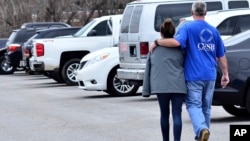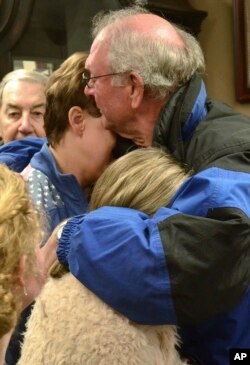The shooting of more than a dozen students at a Kentucky high school might have been expected to shock the nation, but Americans seem numbed by the apparent frequency of school shootings since 20 children and six adults were killed at a Connecticut elementary school in 2012, gun-control advocates say.
President Donald Trump took more than 24 hours to express sorrow about the shooting on Twitter — but tweeted about text messages between FBI agents and immigration in the meantime — while Canada’s prime minister, Justin Trudeau, tweeted condolences and called Kentucky’s governor the same day. Although the story led many newscasts, much coverage of the shooting in Benton, Kentucky, emphasized how students put their safety training into practice, running as far as a mile (1.6 kilometers) to escape the gunfire.
A 15-year-old boy was in police custody after authorities say he walked into Marshall County High School armed with a pistol Tuesday morning and immediately started firing. Two 15-year-old classmates were killed and 18 others were injured.
Everyday events
Gun safety and school safety advocates say the shock factor has disappeared amid years of school shootings, making them feel like common, everyday events.
“It is a story that feels probably like the movie ‘Groundhog Day,’” said Shannon Watts, who founded Moms Demand Action after watching the shooting at a Newtown, Connecticut, elementary school that killed 20 children and six adults.
“It almost is like some kind of bar has been set (since Newtown), and if school shootings don’t reach that bar, then maybe they’re not newsworthy, which is in itself wrong,” Watts later added. “We have to care every time a gun goes off on school grounds, no matter what the reason is ... because we are the only developed nation where this happens.”
Since Sandy Hook, 283 school shootings
In the five years since the Sandy Hook Elementary School shooting, the United States has had 283 school shootings, 11 since just the beginning of this year, by gun control advocates’ count. The day before the shooting in Benton, a 16-year-old boy shot and injured a 15-year-old girl in the cafeteria at a high school in Italy, Texas, barely a blip on the national news.
Katherine Newman’s book Rampage: The Social Roots of School Shootings, zeroes in on two shootings, one of which occurred in Paducah, Kentucky, just 24 miles (40 kilometers) from Benton.
These types of school shootings — rampage shootings — remain uncommon, she said. However, because they are lumped in with all sorts of other shootings near or at schools, they feel like they’re happening more frequently. For example, among the 11 cases this year some count as a school shooting was a 31-year-old man who killed himself in the parking lot of a Michigan elementary school. In researching the 2004 book, Newman said they tracked school shootings from 1970 to 2000 and identified 20 that fit the rampage category.
By the strict definition, no school shootings have happened so far this year except the ones in Kentucky and Texas, plus a teen who killed himself in a school bathroom.
Becoming notorious
Newman said actual school shootings remain rare and occur most often in places just like Benton: small, rural and viewed as idyllic places to grow up. But those qualities sow the seeds for the kids who carry out these shootings, she said.
“These are tiny towns where people feel like it’s a wonderful place to raise your kids because everyone knows your name,” Newman said.
But in these towns, she said, future shooters grow up surrounded by classmates who seem to be enjoying life, excelling in sports or academics, and being raised in wonderful families. They struggle to fit in and, when they can’t, they conjure up shootings as a way to at least become notorious.
“They were trying to get people to think of them as an antihero because that was better than being thought of as a loser,” she said.
Someone knows
School shootings rarely happen spontaneously or without a few classmates having a whiff it might happen. The solution? Finding ways to ensure kids can tell an adult without feeling like snitches or reactionaries.
Robert Boyd, executive director of the Delaware-based Secure Schools Alliance, which works on making schools safer, said the vast majority of mass shootings at elementary schools are committed by an intruder, while those at middle and high schools are by students.
“The malaise, the tolerance that we as a society have built up about students doing violence on other students, we seem to have more collective outrage when it’s an intruder,” Boyd said. “But we’ve just come to accept that it’s normal for a student to walk in with a gun and start shooting.”










